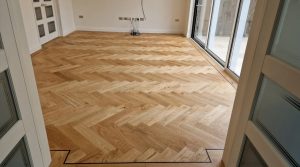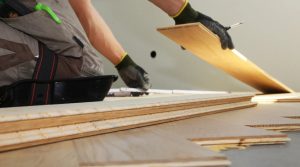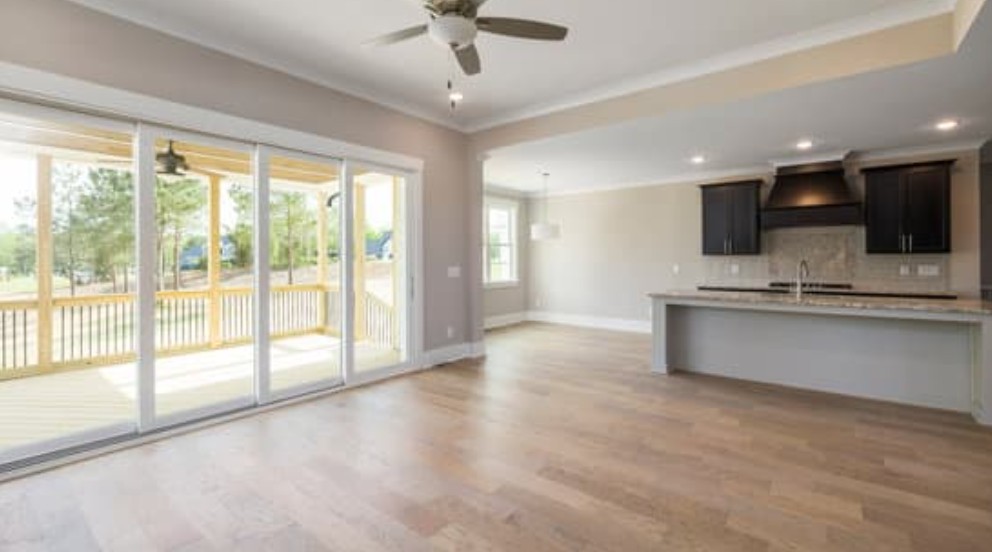Patterns in flooring have always had a way of telling stories, and herringbone, one of the most recognisable, is no exception. Once associated with stately homes and traditional parquet halls, this elegant zig-zag design is enjoying its widespread revival.
No longer reserved for grand entryways, herringbone has found its way into modern kitchens, living rooms, and even small flats. Proving that its appeal stretches far beyond heritage settings.
So, what’s behind this striking comeback, and how can it be incorporated into a contemporary home?
A History Worth Repeating

First appearing in Roman road systems and later in European parquetry, herringbone has always carried an air of craftsmanship and prestige.
Today’s revival has stripped away the stiffness and parted ways with the idea of being a traditional and formal style. Now, herringbone is celebrated for its rhythm, texture, and ability to enhance even the most minimal of spaces.
Why Herringbone Floors Are Everywhere Again?
In an age where interiors lean towards clean lines and neutral palettes, herringbone adds subtle movement without overwhelming the room. Its geometry offers visual interest in the same way as textured plaster walls or boucle upholstery, creating depth without the need for bold colours.
Psychologically, the pattern also brings a sense of order and flow. It guides the eye through a space, grounding it in structure. This makes it particularly appealing in open-plan homes where a distinct yet gentle division of areas can be created.
There’s also the influence of social media, where design-led details thrive. A herringbone floor photographed beneath soft linen curtains and a pared-back oak dining table has become a modern-day interior dream. It conveys both craftsmanship and trend awareness, a balance that resonates with today’s homeowners.
Modern Takes on a Classic Design
Traditional herringbone is often associated with dark oak parquet; the modern version comes in a variety of finishes, materials, and colours.
From pale, whitewashed woods that give a sense of Scandinavian freshness to mid-toned walnuts that create warmth, there’s a look to suit almost every style.
Engineered herringbone flooring has also made it more accessible, providing the look without the painstaking installation or price tag of solid parquet blocks.
For those seeking practicality, herringbone LVTs and laminates are beautiful, cost-effective alternatives to wood, offering durability and ease of maintenance in busy homes.
Sustainability of Herringbone
Another reason for herringbone’s revival is its compatibility with today’s growing focus on sustainable living. Modern versions have evolved to meet both aesthetic and environmental standards.
Traditional parquet relied on solid wood from slow-growing species, making it less eco-friendly, whereas modern alternatives are far more sustainable, with engineered wood leading the way.
Surprisingly, herringbone vinyl flooring can also be eco-conscious with recyclable options and the fact that it’s a long-lasting, durable product that you won’t have to replace anytime soon.
How to Incorporate Herringbone at Home?

Start with the scale of your room. In larger rooms, wide planks make the pattern feel modern and expansive, while in smaller spaces, narrower strips add elegance without overwhelming the proportions.
It’s best to pair herringbone with soft wall colours such as chalky whites, sage greens or muted taupes. This allows the floor to be the star of your room while maintaining a serene backdrop.
Herringbone also works beautifully alongside natural fabrics like linen, jute, and wool. A soft area rug placed over the floor adds contrast while still showcasing the pattern beneath.
And don’t forget about the classic mixing old and new tactic! A mid-century sideboard on a herringbone floor can create a sophisticated contrast, bridging past and present design narratives. Plus, in the evening glow of a table lamp, the zig-zag pattern beneath adds atmosphere and a quiet sense of luxury.
Is the Revival Worth It?
Herringbone’s current popularity definitely isn’t fleeting! Its enduring history and adaptability are proof of that, suggesting that it will remain relevant long after the latest colour of the year fades. So, for those seeking flooring that feels both timeless and stylish, herringbone strikes the balance perfectly.
Of course, it may not suit every space. Homes leaning towards ultra-industrial of rustic farmhouse designs may find simpler wide-plank floors more cohesive.
But for those who enjoy a touch of pattern and heritage in a contemporary setting, this revival is a welcome return.
Author Profile

- Blogger by Passion | Contributor to many Business Blogs in the United Kingdom | Fascinated to Write Blogs in Business & Startup Niches |
Latest entries
 BusinessDecember 12, 2025The Smart SME’s Guide to Future-Proofing Physical Assets
BusinessDecember 12, 2025The Smart SME’s Guide to Future-Proofing Physical Assets FinanceOctober 28, 2025How to Measure the ROI of Your Promotional Product Campaigns?
FinanceOctober 28, 2025How to Measure the ROI of Your Promotional Product Campaigns? Home & LivingOctober 4, 2025Moving Forward When Leicester Family Dynamics Change
Home & LivingOctober 4, 2025Moving Forward When Leicester Family Dynamics Change BusinessSeptember 22, 2025Always-On SMEs: The UK Business Owner’s Guide to Seamless Travel Data for Sales Trips, Trade Fairs & Remote Teams
BusinessSeptember 22, 2025Always-On SMEs: The UK Business Owner’s Guide to Seamless Travel Data for Sales Trips, Trade Fairs & Remote Teams





